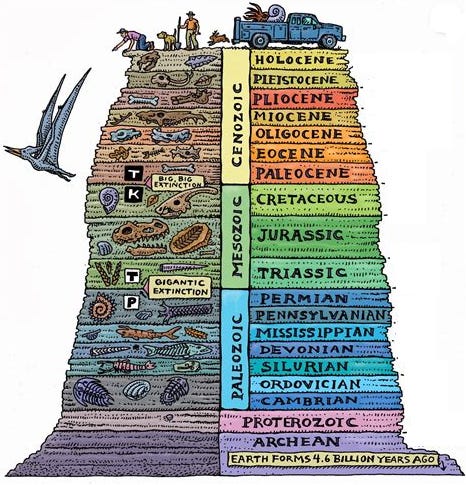{Most of this post is quotes from articles. My few statements are in curly brackets, like this, except for my subtitles.}
DIATOMS
https://inhabitat.com/light-manipulating-algae-could-boost-solar-power-technology/
God’s micro world https://creation.com/gods-micro-world
_Diatoms are among the primary photosynthetic producers of organic materials in the oceans. Huge baleen whales skim the surface for hours, consuming hundreds of kilograms of diatoms with their comb-like teeth. In addition, diatoms are able to produce a high-quality oil. Much of the petroleum reserves found today are in large buried deposits, apparently of diatom origin. Imagine the countless billions of diatoms that must have been sorted and buried suddenly under flood conditions to produce our seemingly endless supply of oil. Large deposits of diatomaceous earth, such as those being mined in Lompoc, California, are merely the left-over glass-houses of diatoms....
WHEN & HOW PETROLEUM & NATURAL GAS FORMED
Did Natural Gas Take Millions of Years to Form? https://www.icr.org/article/did-natural-gas-take-millions-years/
_A recent article titled "Natural gas: A modern fuel millions of years in the making" reported that the refined gas used in barbecue grills "marks the last step in a process that began more than 500 million years ago."1
_But that's not so. Natural gas can be produced by adding heat and water to brown coal. Underground gas and oil, mixed with water, rise from a heated coal deposit until they are either trapped by an overlying rock formation or emerge at the earth's surface. Converting this coal to liquid or gaseous hydrocarbons does not take much time, nor does the upward migration of such material. So where is the evidence that points to millions of years?
_Oil and gas form in days, and they migrate through sedimentary strata to form pools in thousands of years or fewer.
How fast can oil form? https://creation.com/how-fast-can-oil-form
__Coal to Oil in Laboratory
_{There} are laboratory experiments that have generated petroleum under conditions simulating those occurring naturally in a sedimentary rock basin. Between 1977 and 1983, research experiments were performed....
_Two types of source rock were chosen for this study — an oil shale (torbanite) ... and a brown coal (lignite) .... Both these samples were important in the Australian context, since both represent natural source rocks in sedimentary basins where oil and natural gas have been naturally generated from such source rocks, and in the case of the Bass Strait oil and natural gas fields, sufficient quantities to sustain commercial production.
_The products after 250 weeks (350°C) resembled a carbon dioxide rich natural gas. Over the same time period and at those temperatures, the brown coal samples had also been converted to anthracite (the highest grade form of black coal).
_The researchers concluded that overall, the four-year (300°C) results provide experimental proof of oil shale acting as an oil source and of brown coal being a source first of carbon dioxide and then of mainly natural gas/condensate.
_But could these laboratory experiments really have simulated natural petroleum generation from organic matter in source rocks in only six years as stated?
PETROLEUM FROM MARINE ALGAE
__Oil Forming Under Ocean Now
_This ‘natural refinery under the ocean’ is found under the waters of the Gulf of California, in an area known as the Guaymas Basin (see Fig. 1). Through this basin is a series of long deep fractures that link volcanoes of the undersea ridge known as the East Pacific Rise with the San Andreas fault system that runs northwards across California. The basin consists of two rift valleys (flat-bottomed valleys bounded by steep cliffs along fault lines), which are filled with 500 metre thick layers of sediments consisting of diatomaceous ooze (made up of the opal-like ‘shells’ of diatoms, single-celled aquatic plants related to algae) and silty mud washed from the nearby land. Along these fractures through the sediments in the basin flows boiling hot water at temperatures above 200°C, the result of deep-seated volcanic activity below the basin. These hot waters (hydrothermal fluids) discharging through the sediments on the ocean floor have been investigated by deep sea divers in mini-submarines.
_The hydrothermal oil from the Guaymas Basin is similar to reservoir crude oils.9 Selected hydrocarbon ratios of the vapour phase are similar to those of the gasoline fraction of typical crude oils, while the general distribution pattern of light volatile hydrocarbons resembles that of crude oils (see Table of analyses) . The elemental composition is within the normal ranges of typical crude oils, while contents of some of the significant organic components, and their distribution, are well within the range of normal crude oils. Other key analytical techniques on the oil give results that are compatible with a predominantly bacterial/algal origin of the organic matter that is the source of the oil and gas.10
_This oil and gas has probably formed by the action of hydrothermal processes on the organic matter within the diatomaceous ooze layers in the basin. Of crucial significance is the radiocarbon (C14 ) dating of the oil. Samples have yielded ages between 4,200 and 4,900 years, with uncertainties in the range 50–190 years.11 Thus, the time-temperature conversion of the sedimentary organic matter to hydrothermal petroleum has taken place over a very short geological time-scale (less than 5,000 years) and has occurred under relatively mild temperature conditions.
_{Volcanic eruptions during the Flood} would have been superheated water, similar to the hydrothermal fluids found in the Guaymas Basin. The rock record contains many layers of volcanic lavas and ash between other sedimentary layers, many containing organic matter. Thus this model for hydrothermal generation of petroleum is more than a feasible process for the generation of today’s oil and gas deposits in the time-scale subsequent to Noah’ Flood as suggested by creation scientists.
BIBLICAL TIMELINE
{The Bible may or may not be accurate, but it seems to be much more accurate than mainstream science regarding the Flood.}
Receding Floodwaters Buried Deep-Sea Oil https://www.icr.org/article/receding-floodwaters-buried-deep-sea-oil/
_Genesis 8:3, relating the recession of the floodwaters, is now supported by petroleum geologists’ stratigraphic data gathered from 1,544 widespread locations across North America, South America, and Africa.2
_The catastrophe’s zenith occurred on day 150, after which the flooding reversed—actively receding until the deluge drained and the landmasses dried out.5 That pivotal reversal left its marks all over the world’s stratigraphic rock layers. One example is “a large, unusually thick and extensive sand body in the deep water of the Gulf of Mexico [7,600–10,000 feet deep]…so large and completely unexpected that the oil industry dubbed it the ‘Whopper Sand.’”2
_Before day 150, transcontinental tides drenched continents with layer after layer of sedimentary sheet washings. “From the end of day 150” (literal Hebrew in Genesis 8:3), a remarkable reversal (“return”) occurred, followed by continual widespread and powerful drainage dynamics.
WHICH ROCK STRATA PRODUCED SOME OIL
https://tse1.mm.bing.net/th?id=OIP.tRP_-cKwI6o4jnm7v2FUqgHaHq
{Apparently, the Flood deposited all sedimentary strata up to the Miocene/Pliocene boundary. The rest that's above that boundary was likely mostly deposited during the Younger Dryas catastrophic melting of the post-Flood Ice Age ice sheet.}
South Caspian Basin supports a late Cenozoic Flood boundary https://creation.com/south-caspian-basin-flood-boundary
_Massive marine deposits across such vast areas of the world indicate that Flood processes were still active well into the Upper Cenozoic, with strata extending across most of Syria and Iraq; these are areas just to the south of where the Ark landed and where the Tower of Babel was built.14 It is hard to imagine attempting to build a civilization while still under the waters of a Flood. What better proof could be found to make the case that the Flood could not have ended at the K-Pg, but continued through the Miocene at least?
_An examination of the rocks in the South Caspian Basin provides additional confirmation of a late Cenozoic Flood boundary. This area also shows continuous marine strata from the Cretaceous level upwards through the Miocene, and even as high as the Lower Pliocene in the Middle Caspian Basin just to the north.15 Indeed, the Miocene marine rocks in the South Caspian Basin are the source rocks for much of the oil produced in the vicinity. These rocks have been studied by oil and gas companies and found to contain tremendous volumes of buried marine algae; some of these shales contain up to 12.39% TOC (total organic carbon).15
_The claim that mostly continental rocks were deposited after the K-Pg boundary is shown to be utterly false. Uninterrupted marine deposition from the Cretaceous through the Upper Miocene is seen all across Central Europe, North Africa, Syria, and Iraq, and the South Caspian Basin. This prevents the picking of a post-Flood boundary any earlier than the end of the Miocene across this region. The receding phase of the Flood must have continued to deposit sediment throughout most of the Cenozoic across vast regions of Europe, Africa, and parts of Asia at least. Even many of the deposits in the upper Cenozoic across North America are better explained by the receding phase of the Flood, like the vast Ogallala Formation spread across the Great Plains States of the USA.21




